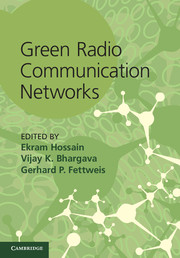Book contents
- Frontmatter
- Contents
- List of contributors
- Preface
- Part I Communication architectures and models for green radio networks
- Part II Physical communications techniques for green radio networks
- Part III Base station power-management techniques for green radio networks
- Part IV Wireless access techniques for green radio networks
- 12 Cross-layer design of adaptive packet scheduling for green radio networks
- 13 Energy-efficient relaying for cooperative cellular wireless networks
- 14 Energy performance in TDD-CDMA multi-hop cellular networks
- 15 Resource allocation for green communication in relay-based cellular networks
- Part V Green radio test-bed, experimental results, and standardization activities
- Index
- References
12 - Cross-layer design of adaptive packet scheduling for green radio networks
from Part IV - Wireless access techniques for green radio networks
Published online by Cambridge University Press: 05 August 2012
- Frontmatter
- Contents
- List of contributors
- Preface
- Part I Communication architectures and models for green radio networks
- Part II Physical communications techniques for green radio networks
- Part III Base station power-management techniques for green radio networks
- Part IV Wireless access techniques for green radio networks
- 12 Cross-layer design of adaptive packet scheduling for green radio networks
- 13 Energy-efficient relaying for cooperative cellular wireless networks
- 14 Energy performance in TDD-CDMA multi-hop cellular networks
- 15 Resource allocation for green communication in relay-based cellular networks
- Part V Green radio test-bed, experimental results, and standardization activities
- Index
- References
Summary
Introduction
In a cellular wireless network, most of the energy is consumed in the radio access network [1]. Over the last decades, a significant amount of research work has focused on spectrally efficient and reliable wireless communications techniques at the physical (PHY) layer. However, the interactions among the layers (e.g. PHY-layer, radio link layer, and network layer) in the transmission protocol stack have to be taken into account to minimize the overall energy-consumption [2] in a green wireless network. The success of such a green wireless technology can be measured by energy-efficient metrics at different levels from the physical to application layer [3]. Energy efficiency across the entire system or network exploiting the layer interactions is notwell understood and needs more attention. The joint optimization of the transmission scheduling and resource allocation (or management) at various layers is referred to as cross-layer optimization. Again, energy efficiency in wireless communications systems so far has primarily focused on uplink communication due to the miniaturized mobile terminals and their limited energy storage capabilities. However, with a significant portion of the wireless internet traffic being from powerhungry base stations to end user mobile devices, energy optimization in the downlink is most important for green radio networks. In this article, we present a cross-layer optimized downlink packet transmission scheduling technique for the realization of green radio networks.
After reviewing some related work on adaptive resource allocation in wireless networks, we discuss why cross-layer interaction, information exchange, and optimization are important for wireless networks, and more specifically, for green radio networks.
Information
- Type
- Chapter
- Information
- Green Radio Communication Networks , pp. 263 - 285Publisher: Cambridge University PressPrint publication year: 2012
